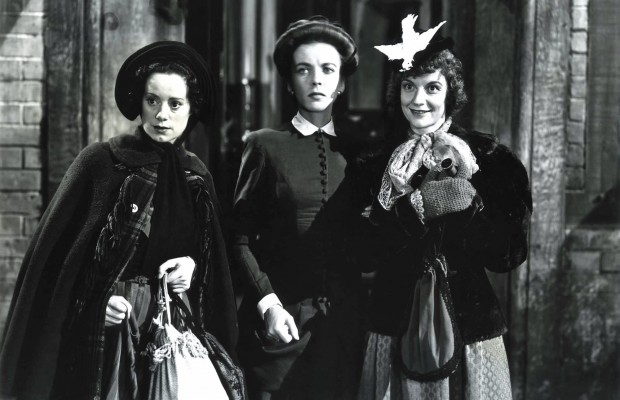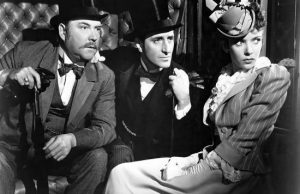Ladies in Retirement (1941)

Toronto Film Society presented Ladies in Retirement (1941) on Sunday, November 2, 2014 in a double bill with Dragonwyck as part of the Season 67 Sunday Afternoon Film Buff Series, Programme 2.
| Production Company: | Columbia Pictures Corporation |
| Director: | Charles Vidor |
| Writers: | Garrett Fort (Screenplay)Reginald Denham (Screenplay) |
| Cast: | Ida Lupino (Ellen Creed)Louis Hayward (Albert Feather)Evelyn Keyes (Lucy)Elsa Lanchester (Emily Creed)Edith Barrett (Louisa Creed)Isobel Elsom (Leonora Fiske)
Emma Dunn (Sister Theresa) Queenie Leonard (Sister Agatha) Clyde Cook (Bates) |
LADIES IN RETIREMENT is an unjustly neglected film. It is a very absorbing little thriller, obviously a play adaptation with its one set, but consistently involving and interesting. Lupino plays housekeeper to a retired actress (Elsom) and persuades her to let her two sisters come for a visit. The two are batty and soon get on Elsom’s nerves. She orders the lot of them out of the house, so Lupino with no avenue of escape, offs her and hides the body. Then begins a cat and mouse game – will she be exposed and who by or will she retain the upper hand? The acting by Lupino and Elsom is excellent as is the wonderfully batty interpretations of the sisters by Elsa Lanchester and Edith Barrett. The marvellous cottage interiors earned a deserved Art Direction Oscar nom as did the atmospheric Musical Score. For my money it also deserved a nod for its beautifully composed Cinematography. – IMDB
Ida Lupino (1918-1995)
Born in London to a show business family, it was expected that she would also follow the family line. In 1934, Ida’s mother brought her to her first audition and succeeded in obtaining her first role as an actress. – Her First Affaire (1932) Not long afterwards, Ida now a bleached blonde, moved to Hollywood playing small, insignificant parts, with Peter Ibbetson (1935) being one of her noteworthy exceptions. It wasn’t until she garnered a role in The Light That Failed (1939) that people began to take notice of her and she started getting better roles.
Lupino was most often cast as a hard, but sympathetic woman from the wrong-side of the tracks and at this she excelled. It was said, at the time, that no one could play hard-luck dames the way that Lupino could play them and in The Sea Wolf (1941) and High Sierra (1941) she played the part magnificently. Ida’s strong presence allowed her to act well against some of the biggest leading men of the day, including Humphrey Bogart, Ronald Colman, John Garfield and Edward G. Robinson.
In the 1940s, Lupino played a range of characters, from a traveling saleswoman in Pillow to Post (1945), to a tough nightclub singer in The Man I Love (1947). The problem was that strong roles for women were few and far between and there was a large pool of young and already established actresses auditioning for the roles. In 1947, Lupino left Warner brothers to become a freelance actress, which didn’t improve her situation.
As better roles did not materialize, Lupino decided to step behind the camera as a director. Her big break occurred when director Elmer Clifton fell ill during the shooting of a script that Ida had co-written. – Not Wanted (1949) Ida was overheard to joke that “as an actress, she was the poor man’s Bette Davis. Now, as a director, she became the poor man’s Don Siegel.” Lupino’s career continued on through the 1950s and consisted mostly of inexpensive melodramas. Later she turned to Television where she directed episodes in shows such as The Untouchables (1959) and The Fugitive (1963).
Louis Hayward (1909-1985)
Born in South Africa, Hayward was brought to England where he was educated there and on the continent. Displaying some acting talent, while working at a London nightclub, he was soon tapped by playwright Noel Coward. Hayward went on to develop his acting skills on the London stage playing such roles as “Dracula” and “Another Language” He made his screen debut in the British romantic drama Self Made Lady (1932), which was followed by five more British films through 1933.
Hayward came to New York to star in the Broadway play “Point Verlaine”. Although this would end up being his one and only Broadway venture, the exposure did get him a lucrative Hollywood contract and his first role The Flame Within (1935). After several supporting roles, Hayward got his first real break playing against Claude Rains in Anthony Adverse (1936). Through the remainder of the 1930s he would have ample opportunities to vary that class of character, starting with some early “B”-tier efforts. His good looks were complemented by an airy manner of speaking, which worked as both hero and rogue or occasional suave villain.
World War II brought Hayward a respite from the vagaries of Hollywood luck. He was a United States Marine combat photographer, and his work during the invasion of the Japanese-held island of Tarawa earned him a Bronze Star for courage under fire. Overcoming the psychological stress of his war experiences, Hayward returned to the Hollywood spotlight. He had already notched a few mysteries on his belt when he was cast in the Agatha Christie thriller And Then There Were None (1945), which was a hit. His subsequent list of romantic parts included yet another “Monte Cristo” adventure: the Robin Hood-like Robert Louis Stevenson adventure The Black Arrow (1948) and a succession of pirate parts. He played in two “Captain Blood” sequels, neither of which turned out well for him. There was also yet another “twin” sequel, this time a twist of the Jekyll/Hide story but with the doctor’s twin sons, called The Son of Dr. Jekyll (1951).
Although he continued to make movies, Hayward ventured enthusiastically into television, not only with some ten American playhouse theater productions and episodic television through the 1960s but productions of his own. He bowed out of acting in the mid-1970s, not the screen legend that he had hoped to be, but wiser and certainly comfortable. On February 21, 1985, Louis Hayward died at age 75 of lung cancer in his home in Palm Springs, California.
Notes by David Burgess












Leave a Reply